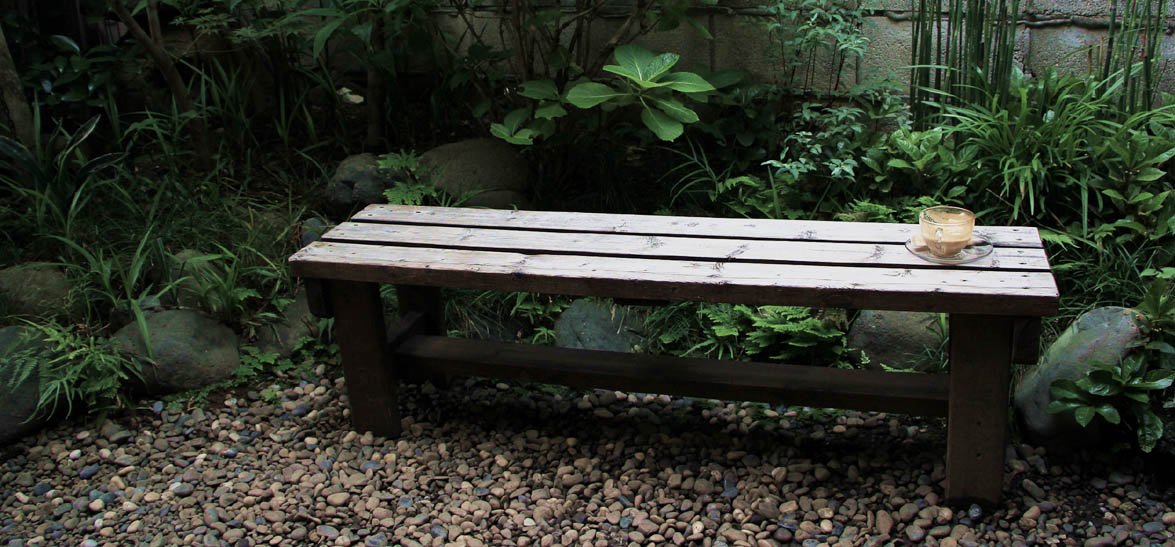Coffee can be hidden.
Behind flagship stores hawking big-name luxury brands and hidden in the back streets of Tokyo’s shopping district of Omotesando is a café that almost isn’t there — unless you are looking for it.
Omotesando Koffee is a pop-up café residing in a 60-year old traditional Japanese house. The café is easy to miss as there are no signages. That’s part of the charm, really. Outside, the house is all wood, bamboo and thatch.
We enter through a small courtyard arranged like a Zen garden, the pebbles crunching softly beneath our soles. The foliage consists of small pots of bonsai and their full-size cousins growing from the earth. A wind chime rings softly in the breeze.
We haven’t been here five seconds and already we feel at peace. There’s a long, low bench, perfect for sitting on and meditating. But where’s the coffee?
Look inside. In what would usually be the front hall of the house, resting on hardwood floors and framed by a series of fusuma panels, is a spare cube-shaped structure: the café.
We soon discern that the cube is a recurring theme – there are square patterns everywhere if you look closely. For owner cum coffee consultant Eiichi Kunitomo, the square represents a kiosk, a minimum of space needed to make good coffee and easily transportable elsewhere.
Once the lease runs out (the house is destined for demolition), Kunitomo dreams of disassembling the café and reconstructing it in different locations around the world. How transient this space is, and so it is with life!





Miki the barista, neatly attired in a white short-sleeved shirt, greets us welcome in Japanese and then some English when we falter in his native tongue. While many of Tokyo’s cafés have typically focused on drip coffee, here at Omotesando Koffee, espresso is king.
Little wonder this as Kunitomo has a wealth of coffee experience under his belt, including setting up the popular Bread, Espresso &. close by as well as overseeing Tokyo’s first Monocle Café. For the Omotesando Koffee house blend, Kunitomo chose beans from Ethiopia, Brazil, Indonesia and El Salvador. Roasting is done in Kyoto by the famous Ogawa.
Using a La Cimbali machine, Miki takes his time pulling an espresso shot. He couldn’t have more than 3 x 3 metres of space to work in but our barista is relaxed and unhurried.
There has been a lot of hoopla about latte art recently, especially intricate designs or gravity-defying 3D constructions. Yet when we observe how Miki carefully foams milk then lifts the cup of coffee up in one hand and slowly combines the yin-yang brew, we realise what true latte art is. Here, before us, the barista is meditating. He pours with awareness.
The resultant cappuccino is not a gaudy masterpiece — no image of cats chasing after fishes here. Instead a simple rosetta formed with a quiet heart and served with a smile on his gentle face. This is more than a caffeinated beverage; this is an offering to a guest.
We thank Miki and take our coffees out to the garden. Sipping slowly, we take in the greenery and the silence that surrounds us. My espresso has a chocolaty sweetness with a smooth body, a very clean cup. The cappuccino has a velvety mouthfeel: delightful.
Rather than a big slice of cheesecake, too rich for the heavy summer afternoon, we share a cube — what other shape would do? — of kashi, their signature baked custard treat. Taken with coffee, it’s a sublime tease of crème brûlée and espresso. One bite, two, all gone. And it’s enough.
This café is not a temple but sit here a while, take your time with your coffee, and you too will be suffused with a sense of serenity. Nothing lasts forever, and in time, this café will no longer exist.
Every cup will remind us to be present in each moment and live in the now.




前兩次到日本遊玩時,我們對咖啡的興趣還不大,
所以也沒特地卻拜訪咖啡館。
不過這次我們可是做足了功課,
綜合了一些網上資料和雜誌的介紹后,我們列了幾家非去不可的咖啡館。
其中一間就是位於表參道的Omotesando Koffee。
表參道除了靠近原宿和明治神宮這些景點外,
同時也是一條充滿了各大品牌旗艦店的名牌街。
不過除了大街上的那些名牌店外,在表參道的一些後巷或小巷子里,
其實還隱藏了不少的特色小店;
如果有時間去走走的話,應該可以發現不少的驚喜。
Koffee就是隱藏在表參道後巷的一家咖啡館。
六十多年的和式老屋,充滿綠意且帶點禪味的庭院;
中間只置了一張長板凳,簡單、自然而不造作;
是我們這次日本自由行中所到訪過最美麗的咖啡館。




如果來的時候是深秋,再配上那滿樹的紅楓;
光想到那景色就已經讓人心醉。
可惜這是一家pop-up café,也就是說這不是一家永久的咖啡館,
應該說不是一家一直會在同一個地點的咖啡館。
聽咖啡師說,原本的租約是一年,滿一年後就會遷移到另一個地點。
雖然租約的時間延長了,不過下次當我們再來東京玩時,
這家咖啡館是不是還會在這個地點,就不得而知了。
我們到訪時不是深秋,沒有看到那滿樹的紅葉,有點小小的遺憾,
不過想想,能夠有機會在那麼漂亮的咖啡館里喝咖啡,也是件樂事。

| Omotesando Koffee オモテサンドウコーヒー [NOW CLOSED] 4-15-3, Jingumae, Shibuya-ku, Tokyo, Japan ooo-koffee.com |




